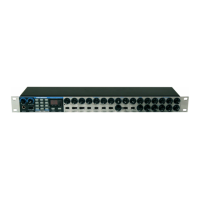Having shown that just three elements make up a sound, these
elements now have to be related to a Musical synthesizer. It is
logical that a different section of the Synthesizer ‘synthesizes’
these different elements.
Oscillators and Waveforms
The Oscillator is really the heartbeat of the Synthesizer. It gen-
erates an electronic wave (which creates the vibrations) at a
controllable musical pitch that has a distinctive tone or timbre.
Many years ago pioneers of musical synthesis discovered that
just a few distinctive waves contained most of the useful har-
monics for musical synthesis. They are known as, Sine waves,
Square waves, Sawtooth waves, Triangle waves and Noise
Waves.
Each one has a specific fixed amount of musically related har-
monics (except noise waves) that can be manipulated by other
sections of the Synthesizer. These waves are referred to as
Waveforms.
A piece of equipment known as an Oscilloscope is able to dis-
play these waveforms on a television type screen. The name
given to the waveform is simply because, when viewed on this
piece of equipment, it looks like its named wave.
The diagrams show how these waveforms look on the
Oscilloscope and illustrate the relative volumes of their harmon-
ics.
In summary, the Oscillators generate Waveforms at a control-
lable pitch. These Waveforms determine the character (Timbre)
of the sound.
9
Oscillators and Waveforms
Synthesis Tutorial
Sine waves have just a single fre-
quency. This waveform produces
the purest sound because it only
has this single pitch (frequency).
Triangle waves contain odd har-
monics only. The volume of each is
the square of its position in the
harmonic series. For example, the
5th harmonic has a volume of
1/25th of the fundamental.
Sawtooth waves contain all the
harmonics of the fundamental fre-
quency. The volume of each har-
monic is proportional to its position
in the harmonic series.
Square waves have only the odd
harmonics present. These are at
the same volume as the odd har-
monics in a sawtooth wave.
Noise waves have no fundamental
frequency and all frequencies are at
the same volume.
Sine Wave
Volume
Volume
Volume
Volume
Volume
Harmonic
Harmonic
Triangle Wave
Harmonic
Sawtooth Wave
Harmonic
Square Wave
Harmonic
Noise

